No products
G.A.R. Encampment - 1891
The 25th Anniversary of their Founding
Grandly Celebrated at Detroit
Detroit is this week the great gathering place of the Nation’s greatest heroes. Ex-soldiers from all sections of the United States reunite there in one grand body and commemorate the greatest deed of valor this Nation has ever witnessed. Governors, ex-governors, congressmen, representatives and men in the private walks of life join in one grand triumphal parade and join hands and hearts while listening to speeches that are grounded with the experiences and hardships of a war that once threatened the overthrow of this grand and glorious Nation. The magnitude of this demonstration is incomprehensible, but at once conveys the unmistakable evidence of the power and influence of the G.A.R. organization.
This is the 25th or “silver” encampment of the Grand Army of the Republic. It was in the year 1866 that the first movement towards the organization of this great body was inaugurated. The founder was Dr. B.F. Stephenson of Illinois. With the assistance of a dozen of his comrades, he instituted a post at Decatur, Illinois April 6, 1866 and soon thereafter posts were started in the state and the United States, until today there is hardly a soldier that is not connected with the G.A.R.
A few surviving comrades of this first post were in the parade at Detroit Tuesday and were quite prominently pointed out to lookers-on. Ohio sent over 13,000 veterans. One interesting feature of their turn-out was the platoon of thirteen lady cadets. The Illinois force was also quite prominent.
[New Bremen Sun – 8/8/1891]
To read about the 1895 G.A.R. Encampment at Louisville, Kentucky, see Civil War Anecdotes on this website.
The Grand Army of the Republic
In early 1866 the United States of America was waking to the reality of recovery from war. In previous conflicts the care of the veteran warrior was the province of the family or the community. Soldiers then were friends, relatives and neighbors who went off to fight until the next planting or harvest. It was a community adventure and their fighting unit had a community flavor.
By the end of the Civil War, men from different communities and even different states were forced together and new friendships and lasting trust was forged. With the advances in the care and movement of the wounded, many who would surely have died in earlier wars returned home to be cared for by a community weary from the war and now faced with the needs of widows and orphans. Veterans needed jobs, including a whole new group of veterans - the colored soldier and his entire, newly freed, family.
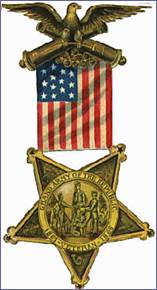 State and federal leaders from President Lincoln down had promised to care for "those who have borne the burden, their widows and orphans", but they had little knowledge of how to accomplish the task. There was also little political pressure to see that the promises were kept.
State and federal leaders from President Lincoln down had promised to care for "those who have borne the burden, their widows and orphans", but they had little knowledge of how to accomplish the task. There was also little political pressure to see that the promises were kept.
Probably, though, the most profound emotion was emptiness. Men who had lived together, fought together, foraged together and survived, had developed a unique bond that could not be broken. As time went by, the memories of the filthy and vile environment of camp life began to be remembered less harshly and eventually fondly. The horror and gore of battle lifted with the smoke and smell of burnt black powder and was replaced with tears for the departed comrades. Friendships forged in battle survived the separation and the warriors missed the warmth of trusting companionship that had asked only total and absolute commitment.
With that as background, groups of men began joining together - first for camaraderie and then for political power. Emerging most powerful among the various organizations would be the Grand Army of the Republic (G.A.R.), which by 1890 would number 409,489 veterans of the "War of the Rebellion."
Founded in Decatur, Illinois on April 6, 1866 by Benjamin F. Stephenson, membership was limited to honorably discharged veterans of the Union Army, Navy, Marine Corps or the Revenue Cutter Service who had served between April 12, 1861 and April 9, 1865. The organization was called a "Post" and each was numbered consecutively within each department. Most Posts also had a name. The rules for naming Posts required that the honored person be deceased and that no two Posts within the same Department have the same name.
Post Commanders, Junior and Senior Vice Commanders and members of Council were each voted into membership using the Masonic system of casting black or white balls (except that more than one black ball was required to reject a candidate for membership). When a candidate was rejected, that rejection was reported to the Department which listed the rejection in general orders and those rejections were maintained in a "Black Book" at each Post meeting place. The meeting rituals and induction of members were similar to the Masonic rituals and were handed down to the Sons of Union Veterans of the Civil War.
The official body of the Department was the annual Encampment. Encampments were elaborate multi-day events which often included camping out, formal dinners and memorial events.
The G.A.R. founded soldiers' homes, was active in relief work and in pension legislation. Five members were elected President of the United States and for a time it was impossible to be nominated on the Republican ticket without the endorsement of the G.A.R. voting block.
In 1868, Commander-in-Chief John A. Logan issued General Order No. 11 calling for all Departments and Posts to set aside the 30th of May as a day for remembering the sacrifices of fallen comrades, thereby beginning the celebration of “Decoration Day”, later to become Memorial Day.
The final Encampment of the Grand Army of the Republic was held in Indianapolis, Indiana in 1949 and the last member, Albert Woolson, died in 1956 at the age of 109 years.
To read this article in its entirety, click here.
Soldiers’ Reunion – JUNE 16, 1895
War Recollections Recalled - They Sing, Shout, Run and Drink to each other’s Health
Two of their Members Recipients of Special Honor
One of the largest and happiest reunions of surviving veterans that ever took place in this vicinity occurred last Sunday at the farm home of William Hoewischer five miles north of New Bremen. The reunion was prominent for two special features, but there were many features within these two which conjointly furnished amusement, recreation and reinvigoration enough to impress itself firmly on the book of memory of all who were present. It is doubtful whether there is any company of ex-soldiers in the State of Ohio that can gather a greater percentage of surviving members on such short notice as Company C of the 37th. The greater portion of the company resides in this immediate vicinity but some have scattered to distant points. Company C, however, was not the only company represented. In all, there were forty-five soldiers and four widows of soldiers besides other relatives and friends making a grand total of 128 people present at dinner. As stated, there were two features prominent. One, the surprising of Comrade Hoewischer and the other the caning of comrade and flag carrier Herman Barnbrock (Barienbrock) of Illinois who is now visiting here.
The soldiers and families began to gather at the beautiful farm home sometime in the forenoon. Delegations came in from every point of the compass, each additional load bringing additional cheer. It may be unnecessary to say that the soldiers, upon meeting, need no formal introduction. They know each enough to warrant them to start in with jollity at first sight. This was done on Sunday. Hardly had Andrew Kohler and D. Fritz, the main songster of the company, reached the house when they picked up a “Delineator” lying on a table, held it upside down and sang out of it stirring war songs which were soon re-echoed by every one of the least musical inclination. The crowd had fairly gathered and the spirit of the occasion was well underway when Captain Charles Hipp arrived with the original flag of the Company. This flag was at Toledo and was sent for for this occasion. The flag bearer of the company, Comrade Herman Barnbrock, was also present but he had no inkling even at this juncture of what was really in store for him.
As soon as Captain Hipp arrived, he handed the old weather-worn bullet-torn flag to its once faithful bearer, and a mighty hurrah went up by all comrades who surrounded the proud flagmaster and sang the patriotic song: “Marching through Georgia”. What a glorious scene this was. It would have sent a thrill of awe and delight through the most stoical and stupid looker on. The soldiers do nothing by halves. With hearts cemented with friendship formed and developed during the darkest hours of the nation’s history, they spare no pains in bestowing tributes of respect to persons rightfully deserving them. This done, Comrade Ben Schulenberg was detailed to execute a warrant of arrest upon Comrade Barnbrock. The prisoner was brought before Judge William Schulenberg and before he could catch his breath and explain away any of his misdoings, the charge was openly read to him and quick justice meted out. Judge Schulenberg charged the prisoner in his characteristic interesting style. Evidence was gathered beforehand and about all that Comrade Barnbrock could do was to plead guilty to every charge preferred.
Comrade Barnbrock was charged Firstly with leaving his peaceful pursuits of business in 1861 and deserting his home and loved ones to take up arms against his fellow-men; Secondly, with boarding railroad trains and steam boats without saying “thank you” to the conductors; Thirdly, with invading the fields and gardens of the Southern people and shooting holes through Southern people for no other reason than the hauling down by the Southerners of the old flag from Fort Sumter and substituting a “brand new one”; Fourthly, with violating the rules of health by wading through swamps and rivers for days and nights without changing his clothes which consisted chiefly of holes, by sleeping on hard and frozen ground when he ought to have been home tucked up between two feather beds, by treating his stomach to two beans soaked in hot water when it craved chicken pot-pie and when it craved for quail on toast, he gave it quail on the fence 15 miles away; Fifthly, with carrying the flag during the storming of Southern forts and rifle pits, marching with it over the dead bodies of Southerners and wounding the feelings of those who escaped death by flinging it in their faces and finally deserting them to return to the North and accepting the advice of Horace Greely to go west and grow up with the country.
The Comrade having pleaded guilty to all these charges, the jury which comprised the entire congregation of comrades was asked what should be done with him. They simultaneously shouted, “Cane him! Cane him!” And caned he was. A gold headed cane with the inscription “Presented to Herman Barnbrock by the surviving soldiers of Company C., O.V.I. No. 37, June 16, 1895” was handed over to him accompanied by an appropriate address from Judge Schulenberg. The recipient of this honor was filled with emotion and gratitude and very gracefully accepted the gift. He subsequently said that he wouldn’t part with the cane for a 40-acre farm.
Immediately after this ceremony, another warrant of arrest was issued upon Mr. and Mrs. Hoewischer. The former was charged with being an accomplice of Comrade Barnbrock and the latter for assisting and encouraging a husband who took an active part in the late Civil War. The couple could not evade the proof against them and likewise pleaded guilty to the charges preferred, whereupon they were presented with a handsome red chair.
The remainder of the day was passed in swapping war recollections, singing war songs, playing football, running foot races and other items of amusement and pastime. The entire farm was in the hands of the guests and exercised nearly as much freedom and ease as was their wont in the 1860s. Following is a list of all the soldiers and widows of soldiers who were present:
Company C - 37th, O.V.I.
Chas. Hipp, Capt.; Henry Schmidt, Capt.; Henry Finke, Lieut.; Herman Barnbrock, Flag Carrier; Henry Heman, Fred Dickman, John Keifer, Jacob Keifer, Wm. Kohlhorst, Fred Roettger, A. Friederich, F. Heusch, F. Buchholtz, H. Wieser, M. Brodbeck, Chas. Prange, F. Tellman, H. Eppighausen, A. Kohler, R. Schroeder, C. Schnell, H. Kettler, B. Schulenberg, Wm. Schulenberg, C. Aue, D. Fritz, L. Lambert, Jacob Weiler, Wm.Hoewischer, John Schneider, Mrs. John Blase, Mrs. John Buchholtz, Mrs. George Knost.
Company H - 37th, O.V.I.
F. Hilgemann, Wm. Waterman, F. Hummel, Geo. Burmeister, P. Flath.
Co. A - 52 Ohio: Mrs. H. Dryer | Band - 37: John Goetz | Co. C - 10 Kan.: J. C. Titus |
[New Bremen Sun - Saturday June 22, 1895]
Albert C. Buss, Editor & Proprietor
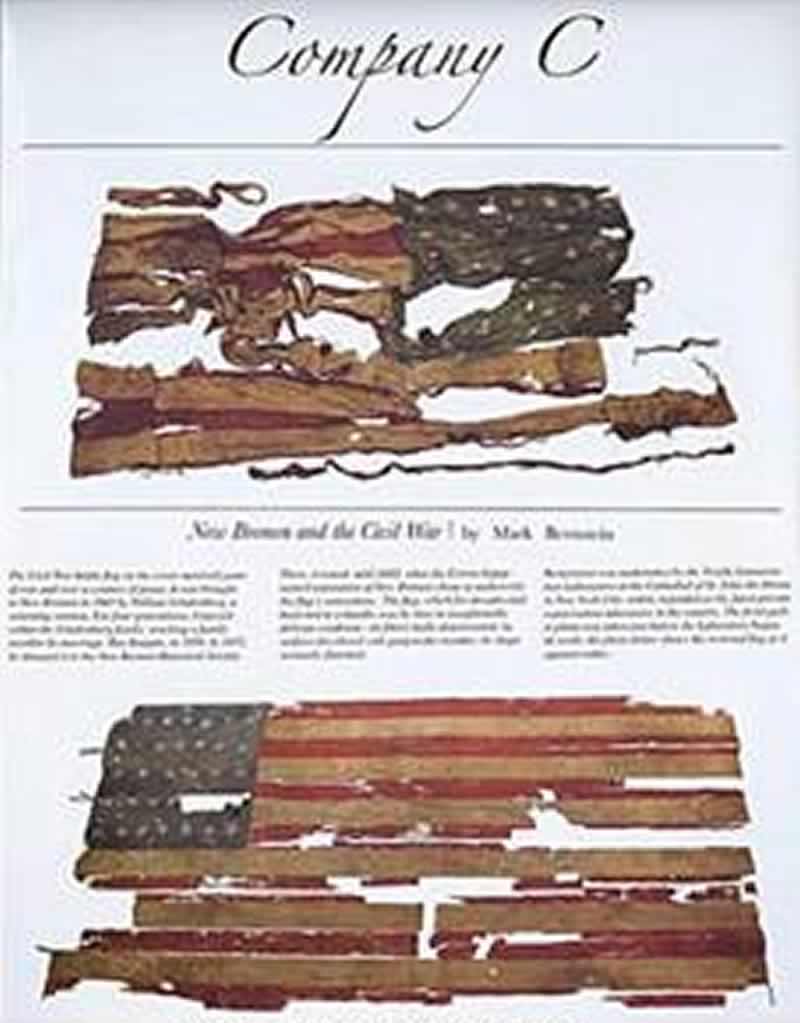
"Company C - New Bremen and the Civil War" the book is available from our Museum Store
Beautifully Remembered Were the Heroes of the Late Civil War
Flowers Profusely Strewn
Music and Song Combine With Oratory to Pay Tribute To Country’s Patriots
Decoration Day 1897 received its share of attention here. Probably a little more interest was shown this year than ever before. The parade was certainly one of the prettiest seen on a similar occasion and the interest that was shown in the preliminary arrangements was quite general. Everybody seemed to be willing to contribute something towards honoring the soldiers dead. Dame nature herself smiled serenely, putting the garb of life to fields and forests and beckoning the flowers to shed their splendor upon a grateful people. The graves of loved ones were strewn with flowers giving to the eye an exemplification of human tenderness and loving affiliation. The sentiment that is at the back of these little deeds is grander than can be depicted by the pen of ye humble writer.
The day was pleasant and the exodus of people to the cemetery, where the exercises were held, was large. Those who took part in the parade had all received some previous drill in marching and the manual of arms. The soldiers, as old as they are, kept time to the martial music of the Little Six Band with a vim; the High School Cadets, under the command of Captain Frank Kettler, escorted them; the school children, who are daily being drilled in marching, kept step to the beats of their drum corps; and the Knights of Pythias, arrayed in a special headgear in the shape of a tourist hat and manipulating a cane, were especially drilled by Captain George W. Tooill, who also was their commander for the day. Citizens in carriages joined the procession and taking it altogether, it was indeed a splendid turn-out.
At the cemetery, after the graves had been decorated, an address given by Comrade William Schulenberg, and a salute fired, a program of exercises was given in the chapel. Hon. C.G.O. Miller of Celina was the speaker of the day and reviewed in his style the progress recorded by the human race in the line of liberty, dating back as far as Egyptian idolatry. Songs were sung by the schools and prayer offered by Rev. Shaley.
[The New Bremen Sun – 6/4/1897]
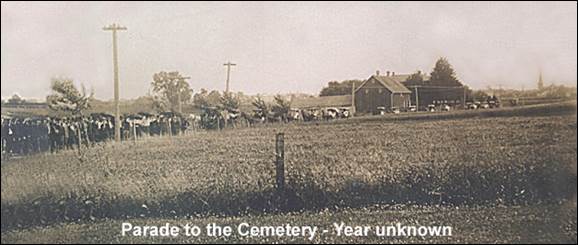
Parade to the Cemetery
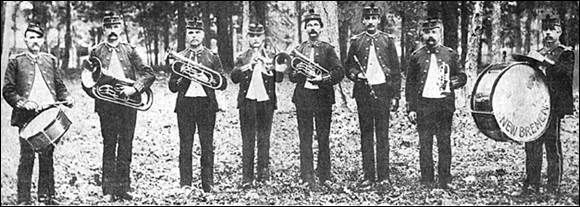
LITTLE GERMAN BAND
(also known as the Little Six Band)
August Wehrman, Henry Weinberg, Christ Laut, Ferd Laut, Theobald Steinebrey (leader), Herman Mohrman, John Laut, Fred Pape
[Taken at the first Tri-County Fair held in 1887]
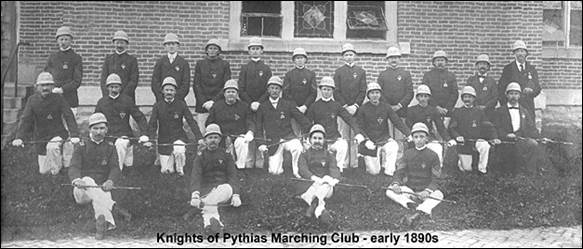
THE RATHBONE LODGE NO. 543 KNIGHTS OF PYTHIAS MARCHING CLUB
STANDING: Albert C. Buss, Martin Knost, Lafe W. Kunning, Charles Block, Fred A. Ende, Herbert Schulenberg, Frank Huenke, Gregor Gast, Dr. M.S. Ekermeyer, Ohio W. Taylor,and August Dierker.
KNEELING: John Thiesing, August Faehl, Henry C. Meyer, Gottlieb Laut, William F. Boesche, Ferd W. Rabe, Edward Millette, John Beams, James Feather, Henry Beard..
SEATED: Fred W. Greber, George W. Tooil (Captain of the squad), Emil W. Laut, and Dr. F.W. Everist.
Red Chair Surprise
Surprised by his Soldier Friends
The ex-soldiers of this place and vicinity gathered at the home of William Schulenberg and wife Sunday afternoon to honor them with a red chair surprise. The hosts were taken unawares but submitted to the gentle graces of their friends with due courtesy and willingness. Captain Henry Finke was spokesman and lost no time in telling his comrade and his comrade’s estimable better-half what they were charged with for which they had to pay penalty. The charges were listened to attentively and the penalty was accepted with all the graces that Comrade and Mrs. Schulenberg could command. The red chair was accepted with thanks and a right pleasant day was spent. Comrade H.F. Roettger and his wife were present and they were also made victims and presented with a red chair.
The following were present from St. Marys: Maj. Chas. Hipp; Capt. L. E. Lambert; Fred Heusch, wife and daughter; Henry Schulenberg, wife and daughter; Henry Weiser; J. Dose and wife.
From Wapakoneta: Capt. Henry Schmidt and wife; Andrew Kohler; David Fritz; Jack Weiler.
From Minster: A. Friedrichs and wife; Mrs. George Knost.
From New Bremen: Capt. Henry Finke, wife and daughter; J.F. Zwez and wife; Henry Schaefer; Fred Tellman and wife; Wm. Kohlhorst and wife; Fred Behm, wife and daughter; Fred Roettger and wife; Fred Dickman and wife; George Burmeister; Christ Aue and wife; Ben Schulenberg and wife; Henry Kettler, wife and daughter; Bill Watermann; Mrs. Dr. M. Stone; Mrs. John Blase; Mrs. Henry Dryer; Mrs. John Bucholtz; Mrs. D. Schroeder, son and daughter; C.P. Gress and family; Ed Langhorst and family; Walter Neuman and wife.
[New Bremen Sun – 11/5/1897]
VICKSBURG REVISITED BY OHIO SOLDIERS
Old Battle Field to be Converted into Park Soldiers Locate Position of their Regiments during Battle
Former Scenes Brought Back to View and Former Experiences Recalled
by William Schulenberg
The writer, accompanied by Major Chas. Hipp of St. Marys and A. Kohler of Wapakoneta left St. Marys on the morning of November 5, 1901 for Vicksburg and Jackson, Mississippi to view the old battlefield and assist the Ohio Commission in locating the position of the 37th O.V.I. and other regiments during the memorable siege of Vicksburg where we, 38 years ago, applied for admission with leaden pellets. The fall of Vicksburg occurred on the 4th of July, 1863, when Gen. Pemberton surrendered to Gen. Grant with 31,000 prisoners and all the implements of war.
We arrived at Vicksburg at daybreak November 7th and spent the forenoon in reporting to Capt. Rigby, the acting Superintendent of the National Park Commission, and in taking in the city. In our jaunt over the city, we were accompanied by Comrade Joseph Tangeman, formerly a member of Co. C., 37th O.V.I., and a resident of Minster, but the past 34 years a resident of Vicksburg. He was not a little surprised and glad to see us. In the afternoon, we drove to the battlegrounds, accompanied by Supt. Rigby, where the writer and Comrade Kohler were put to the test of locating our position. Major Hipp, having visited the battle grounds last spring, was more familiar with it.
On account of the changes made upon the grounds during the past 38 years, we were somewhat at a loss to locate our position; remembering however that a certain spring of water was within 300 or 400 yards of where we stood, we asserted that if we could find that spring, we would get our bearings without difficulty. We did, and found it where we claimed it to be. The spring was down in a ravine and facing the enemy’s works from this spring, the surroundings became quite familiar.
Our position in the charge having been fixed and corroborated, we were next invited to find the location of our camp. On this point, we could not agree. We then returned to the city and spent the evening with friends and Confederate soldiers. I want to say right here that the greetings we received from the old veterans of the Confederate Army were quite the opposite of what is generally expected by the people of the North. Their warm handclasps and smiling faces told unmistakably of the respect they entertain for their former antagonists.
There are some people, it is true, who harbor an abiding grudge against the Yankee soldier, but they belong to that class who have never seen active service in the war. These in turn poison the minds of their offspring; consequently you find some of the younger generation who look with disdain upon the old and grizzled Union defenders. We could plainly discern this feeling in some that we met. The old southern veteran does, however, not belong to that class. The chief of police and many of his sub-ordinates were old veterans of the Confederate army and these welcomed us heartily. They vied with each other to please and entertain us.
The next morning, Capt. E.T. Hayes of Coshocton, Ohio, a member of the Commission, arrived and joined us in another trip to the battlefield. He took several pictures of the grounds, including ours standing on our works. After taking another view of our position, we became more familiar. We returned to the city for dinner, after which we visited the National Cemetery, the most beautiful in the Union, where 16,783 Union soldiers are buried who were killed or died from wounds or disease in and around Vicksburg. Supt. F. Clarksdale piloted us to the graves of those from our regiments. These were decorated with beautiful flowers gathered from the flower beds of the cemetery by permission of the Superintendent.
All of the graves are marked by marble head-stones and numbered, but out of the entire lot, only 4,019 are known. These have their names, the Company, and regiment inscribed on them – the rest are marked “unknown”. All receive the same care and attention, however.
On Saturday morning we again went to the battlefield, accompanied by Supt. Rigby, his surveyor and two members of the Park Commission to permanently locate our positions. Stakes were driven and record made thereof. As soon as all the regiments are located that took part in the siege, the Government will push the work to completion. It will, however, require several years to do so, and necessitate the expenditure of thousands of dollars, but when completed will be the largest and without doubt one of the most interesting and most beautiful parks in the Union.
In the afternoon, we were chaperoned through the cotton gins and cotton seed oil mills by a Confederate soldier. The cotton industry of Vicksburg is of immense proportions. It is claimed to be one of the largest in the south. The labor in them is all performed by Negroes (Supt. and clerks only being white) and a jolly set they are while busy at work. They sing and whistle continually.
On Sunday evening we left for Jackson, the capital of the state. We arrived there Monday morning, visited the State House, which we partly occupied 38 years ago, called on the Governor and other state officers, and were most cordially greeted by all. We also made a trip to the battlefield nearby where our regiment was engaged. On the site of the battlefield is now a Negro deaf and dumb asylum. On entering this institution, we were surprised at the un-cleanliness that existed there. The furniture resembled the country schools of the North 100 years ago. The chairs were broken excepting three which were offered to us, and some of the pupils were seated on rough planks supported by broken chairs. The teacher, a white man, but also deaf and dumb, had his pupils to write their names on the blackboard, and other lessons which were well done. At the suggestion of Major Hipp, I stepped up to the blackboard and wrote: “We are from Ohio, former soldiers who fought a battle right here.” When the children had read this, they almost rose from their seats and gave numerous signs of joy and appreciation. Some pointed to the empty sleeve of Major Hipp, as if asking whether he had lost it there. When I pointed southward they seemed to understand and their faces bore expressions of grief. When we left, the teacher warmly shook our hands and the scholars waved a kind farewell.
We returned to Vicksburg, and started homeward, stopping off at Indianapolis for two days and attended the reunion of the Army of the Tennessee held there. We arrived at St. Marys on Friday, November 15th, at 1:00 P.M., having spent ten days of sight-seeing and recreation. We have had a longing desire to once more visit the fields of battle and were more than pleased with the trip.
As to the general conditions of the South, I have to say that although many changes have been made since the boys in blue were there conducting a war, it is a hundred years behind the North.
[New Bremen Sun – 11/22/1901]
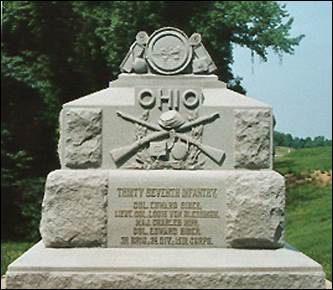
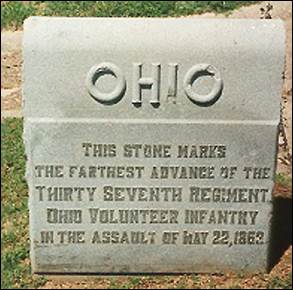
Vicksburg National Military Park
This 37th Ohio Infantry monument is located on Union Avenue 150 yards south of Graveyard Road - also, markers designating the assaults of May 19, 1863 and the assaults of May 22, 1863. This unit was attached to Brig. Gen. Hugh Ewing's 3rd Brigade of Maj. Gen. Francis P. Blair's 2nd Division, Maj. Gens. William T. Sherman and Frederick Steel's XV Army Corps and was commanded by Lt. Col. Louis Von Blessings (wounded May 22, 1863), Maj. Charles Hipp and Col. Edward Siber.
Park Legislation and Mission
Establishment Act February 21, 1899
Enabling Legislation establishing Vicksburg National Military Park
An act to establish a national military park to commemorate the campaign, siege, and defense of Vicksburg.
In order to commemorate the campaign and siege and defense of Vicksburg, and to preserve the history of the battles and operations of the siege and defense on the ground where they were fought and were carried on, the battlefield of Vicksburg, in the State of Mississippi, is hereby declared to be a national military park whenever the title to the same shall have been acquired by the United States and the usual jurisdiction over the lands and roads of the same shall have been granted to the United States by the State of Mississippi.
MARKING LINES OF BATTLE, STATE TROOPS
SEC. 6. It shall be lawful for any State that had troops engaged in the siege and defense of Vicksburg to enter upon the lands of the Vicksburg national military park for the purpose of ascertaining and marking the lines of battle of its troops engaged therein.
PROVISIONS APPLICABLE TO PERSONS AND ORGANIZATIONS
The provisions of this section shall also apply to organizations and persons; and as the Vicksburg National Cemetery is on ground partly occupied by Federal lines during the siege of Vicksburg, the provisions of this section, as far as may be practicable, shall apply to monuments or tablets designating such lines within the limits of that cemetery.

